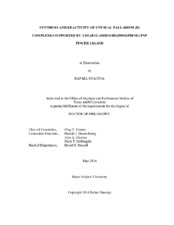| dc.description.abstract | This dissertation discusses the synthesis and reactivity of divalent palladium complexes supported by diarylamido bis-phosphine pincer ligands (PNP). The PNP is a tridentate pincer type ligand which typically adopts meridional type coordination. The rigidity and tight coordination of the PNP ligand provides the unique opportunity to study the coordination of ligands such as O_(2) and C_(2)H_(4) to a single coordination site on palladium, or the reactivity of a single empty coordination site trans to a weak trans-influencing ligand such as diarylamido.
Irradiation of [(^(F)PNP^(iPr))Pd-]_(2) under an atmosphere of dioxygen irreversibly produces a mixture of a monohapto palladium(II) superoxide ((^(F)PNP^(iPr))PdO_(2)) and a palladium µ-peroxide ([(^(F)PNP^(iPr))PdO-]_(2)). Under photolytic conditions these two complexes are in equilibrium with each other. (^(F)PNP^(iPr))PdO_(2), an open-shell paramagnetic species, was characterized by a combination of single-crystal X-ray crystallography, EPR, and ^(19)F NMR spectroscopies. In addition, irradiation of [(PNP)Pd-]_(2) under an atmosphere of C_(2)H_(4) produces a mixture of [(PNP)Pd-]_(2) and a ethylene-bridged dinuclear palladium complex ([(PNP)Pd-CH_(2)-]_(2)). If the ethylene headspace is removed, and [(PNP)Pd-CH_(2)-]_(2) is irradiated it is completely converted to [(PNP)Pd-]_(2). This suggests that in the presence of ethylene these two complexes are in photolytic equilibrium with each other.
In addition, this dissertation will also discuss the synthesis and reactivity of [(PNPR)Pd]^(+) (R = ^(i)Pr, ^(t)Bu) cations. [(^(F)PNP^(iPr))Pd]^(+) cations are highly electrophilic complexes that are able to coordinate Lewis bases such as THF, H_(2)O, and even extremely poor Lewis bases such as toluene and benzene. In addition, irradiation of [(^(F)PNP^(iPr))Pd]^(+) cations in bromobenzene induces the abstraction of a bromine atom from bromobenzene, consistent with a metalloradical species. Addition of dioxygen to [(^(F)PNP^(iPr))Pd]^(+) cations generates a paramagnetic, cationic η^(1) superoxide.
In non-halogenated arene solvents [(^(F)PNP^(iPr))Pd]^(+) cations undergo a highly unusual photo-induced isomerization of the isopropyl groups on the supporting phosphines to n-propyl. This unprecedented isomerization is believed to occur via C-P bond cleavage and is driven by the decrease in sterics around the metal, which allows for the facilitated coordination of the arene solvent. | en |


